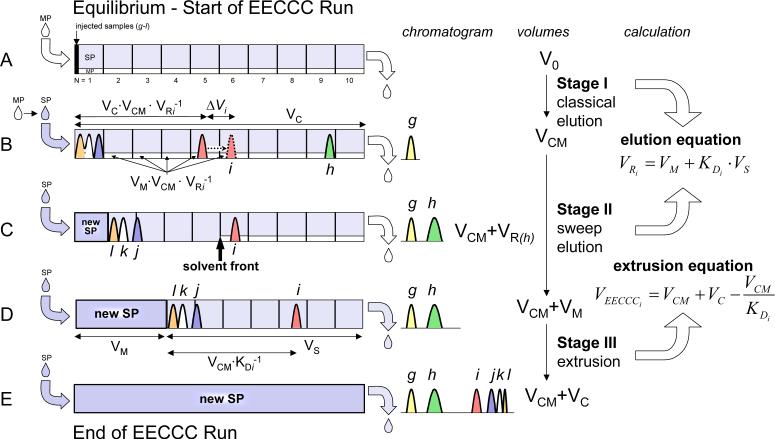Figure 2.
The EECCC concept using the volume approach and a hypothetical mixture of six solutes, g to l, in a theoretical 10-cell CCC machine. Inside the column, there are denser mobile phase (open mixing zone in the column) and lighter stationary phase (dashed). The droplet with arrow at left indicates solvent inlet, whereas the droplet at right indicates solvent outlet. A) the beginning of the run. All six solutes are at the inlet of column. Mobile phase is being pumped in and eluting. B) After a VCM volume of mobile phase has been used to separate the 6 solutes with only solute g coming out, the sweep stage begins as the inlet was just switched to stationary phase from mobile phase. Solute i is at VC×VCM×VRi−1 (ml) from the inlet and has VM·VCM·VRi−1 (ml) of mobile phase behind it. ΔVi is the additional volume i will travel during the sweep stage. C) The end of elution for i, all the mobile phase behind is now replaced by new (previously stationary) phase. Hereafter i will NOT be partitioned and will only “slide” in the column. Solute h, which was inside the column at the beginning of the sweep stage, has also been eluted. Solutes j/k/l, which had not been separated at 2B, achieved separation due to further partitioning during the sweep stage. D) The end of the sweep stage, all the mobile phase is now replaced by new stationary phase and the first droplet of stationary phase comes out from the outlet. This is the beginning of extrusion. KD of any solute came out before this point should be calculated with classical equation (i.e. eq1). E) The end of the run, everything injected in the column has come out in the form of thinner and thinner peaks, even solute l with KDl = ∞, the thinnest peak.

